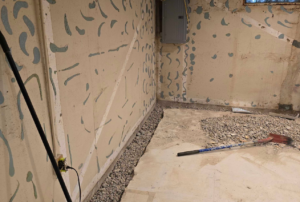If you’ve ever walked into your basement and noticed a wall starting to lean inward or crack, you’re not alone, and it’s something that needs attention sooner rather than later.
Bowing basement walls are a frequent problem for homeowners across Kentucky and Southern Indiana, especially in areas with lots of rain, clay-rich soil, or older homes. But what does it actually mean when your wall is bowing, and how can you fix it?
Let’s walk through the facts so you can take action to keep your home solid and secure.
What Are Bowing Basement Walls?
Put simply, a bowing wall is a wall that’s curving or leaning inward. This usually happens because of pressure from the outside, mainly from soaked soil pushing against the wall after rain.
Here’s the thing: basement walls are built to hold back dry soil, not waterlogged earth. When the soil gets too heavy, your wall may start to bend. If left alone, it can crack, leak, or even collapse.

What Causes Walls to Bow?
The most common cause is water pressure in the soil, but several local factors make this worse:
- Clay-heavy soil that expands when wet
- Poor yard drainage or gutters that dump water near the foundation
- Heavy rains that saturate the ground
- Flat yards or yards sloped toward the home
- Tree roots or added weight near the foundation
- Construction issues, like poor backfilling
Over time, this pressure builds and pushes your wall inward.
Signs Your Basement Wall Is Bowing
Here’s what to check for when you walk into your basement:
- Horizontal or stair-step cracks in the wall
- Walls curving or bulging inward
- Doors or windows that stick
- Water leaking near the base of the wall
- Gaps where the wall meets the ceiling or floor
Even small shifts can grow into bigger structural problems. It’s smart to take action early.
Why This Problem Shouldn’t Be Ignored
Leaving a bowing wall unfixed can cause serious damage. It may weaken the structure of your home and allow water to seep in. That means:
- Mold growth and poor air quality
- Increased repair costs down the line
- Reduced home value
- Delays or issues during resale
- Safety concerns for your family
This is one of those problems that only gets worse with time, handling it early can save money and stress.
How We Fix Bowing Basement Walls
At KCS Foundation and Waterproofing, we help homeowners across the region get real, long-lasting solutions. Depending on the level of damage, we may recommend:
-
Wall Anchor Systems
These are steel rods that help pull the wall back and stabilize it.
-
Carbon Fiber Straps
A strong, non-intrusive option for mild to moderate bowing. Thin and barely visible after installation.
-
Steel Beam Reinforcements
Installed inside the basement to add extra strength where the wall has moved the most.
-
Pier Systems
Helpful when the bowing is caused by foundation settling, not just soil pressure.
-
Drainage and Grading Improvements
Sometimes, fixing the slope of your yard or installing better drainage can reduce future pressure.
Our team chooses the best option for your home after a full inspection.
Why Homeowners Work With KCS
We’re a local company with over 85 years of combined experience fixing foundations across Kentucky and Southern Indiana.
Here’s what you can expect from us:
- Repairs that fit the soil, structure, and climate in this region
- Free inspections and estimates, with no pressure to buy
- Strong warranties that stay with your home, even if you move
- Clear communication and fair pricing
- A team that treats your home like their own
In case you are curious, here’s our range of services, check it out!
What You Can Do Today
Even if you’re not ready to make a call, you can do a few things now:
- Walk around your basement and look for bulges or cracks
- Keep an eye on where rainwater goes, make sure it flows away from your house
- Take a few pictures to keep track of any changes
- Check your downspouts and gutters for clogs
And if anything looks off, we’re happy to take a look and give you honest feedback.
Frequently Asked Questions About Bowing Basement Walls
How much bowing is considered serious?
A wall that bows more than 1 inch inward should be looked at. More than 2 inches can mean the structure is at risk and needs to be repaired as soon as possible.
Can I sell my home if I have bowing walls?
You can, but most buyers will ask for a repair or discount. Fixing the issue before listing helps speed up the process and keeps your home’s value strong.
If you need help fixing your bowing walls, get your free estimate here.
What’s the difference between wall anchors and carbon fiber straps?
Wall anchors are better for more serious movement and can shift the wall back into place. Carbon fiber straps are great for minor bowing, they hold the wall steady but don’t reverse the curve.
Is it okay to finish my basement if the wall is bowing?
It’s best to hold off. Covering the wall can hide damage and lead to bigger problems later. Fix the wall first, then finish the space.
Let’s Fix It Before It Grows
If your basement wall is starting to curve or crack, now’s the time to act. Let our local team take a look. We’ll give you clear answers, a free estimate, and a solid plan to fix it.
Get in touch with our team here.
Kentuckiana Contracting Services, protecting homes across Kentucky and Southern Indiana.

